

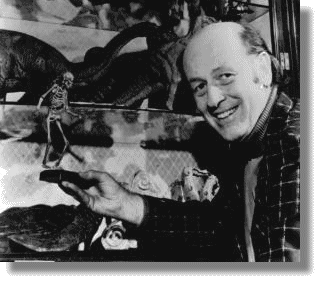

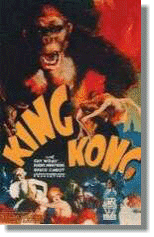 Ray was
born to Fred and Martha Harryhausen in Los Angeles. His early years were
filled with the real onslaught of the motion picture industry. He had seen
THE LOST WORLD (1925), a special effects masterpiece
and forerunner to KING KONG (1933) as a child
of 5 or 6 and while impressed by the special effects work, fate would bring
him to see KONG and he would forever be inspired by the effects creator of
the film, Willis O'Brien.
Ray was
born to Fred and Martha Harryhausen in Los Angeles. His early years were
filled with the real onslaught of the motion picture industry. He had seen
THE LOST WORLD (1925), a special effects masterpiece
and forerunner to KING KONG (1933) as a child
of 5 or 6 and while impressed by the special effects work, fate would bring
him to see KONG and he would forever be inspired by the effects creator of
the film, Willis O'Brien.
Ray's aunt was a nurse to Sid Grauman's mother. While caring for her, his aunt received free passes to see the film playing at the famous Grauman's Chinese theater. Taking Ray with her, he suddenly found himself in another world filled with prehistoric creatures and a giant gorilla. This Gorilla, of course, was KING KONG. Ray would be changed forever.
KING KONG (1933) is regarded by many as the greatest stop-motion picture ever made and some go as far as to say that it is the greatest fantasy films ever made. It is a near-perfect melding of all the elements that make a perfect film and certainly stands among the classic films of all time. Many of the effects have yet to be surpassed. The history of King Kong is worthy of far more mention than I have space for here but in the end it is Willis O'Brien magical special effects work that really makes this film work. If you would like to see more on King Kong then I suggest you check out Boyd Campbell's excellent King Kong - The Eighth Wonder Of The World site.
Ray began doing stop-motion work on his own after purchasing a 16mm camera He also began creating clay sculptures of dinosaurs. Fate intervened once again when, during school he noticed a girl reading a book that turned out to be the original screenplay for KING KONG. After striking up a conversation with her, he discovered that she was Willis O'Brien's niece and she told him to call her uncle. A meeting was arranged and soon Ray was showing Mr. O'Brien his clay statues. Mr. O'Brien was very friendly and offered the suggestion to Ray that he should study anatomy because the legs his of stegosaurus statue resembled sausages. Ray would throw himself into the study of anatomy and his work improved.
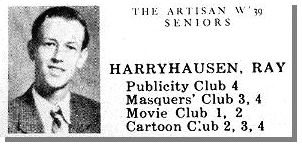 |
Ray's Yearbook Entry |
During this time period, Ray was associating in a circle of friends that would soon inspire generations to come. Ray went to see a re-release of KING KONG for 10 cents at a theater in Hawthorne, a suburb of Los Angeles. The theater lobby had a collection of 11 x 14 stills from the film. Ray asked the theater manager is he could borrow the stills to make copies for himself and the manager explained that he didn't own the stills but gave Ray the telephone number of the person who did, Forrest J. Ackerman. Ray contacted Forry, who graciously allowed Ray to borrow them and the two struck a friendship because of their love of Kong. Forry suggested that Ray attend a meeting of other science fiction and fantasy fans called the Los Angeles Science-Fiction Society, who met on Thursday's nights in the Brown Room of Clifton's Cafeteria. Among those who regularly attended the meetings was an aspiring writer, Ray Bradbury. Ray Bradbury would go on to become one of the foremost science fiction author and Ackerman would become a household name to thousands of adolescents during the 50's when FAMOUS MONSTERS OF FILMLAND would hit the newsstands. Together these three discussed the future and many elements of the fantastic. These early youthful dreamings would draw them all to their future callings.
|
Ray Bradbury, Ray Harryhausen, Forrest J Ackerman |
Ray would concentrate on his studies while beginning experiments in stop-motion in his own backyard and garage. He studied photography and went to the University of Southern California to learn art direction while he was still in high school. He also took a course in film editing. Around 1939, Ray had developed a story idea for a film about a creature from Jupiter and created sketches for the film as well as a model. Ray filmed some sequences for the film in black and white but the project was never fully realized. A picture of Ray working on this projected was published in POPULAR MECHANICS at the time.
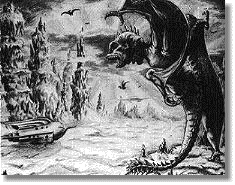 |
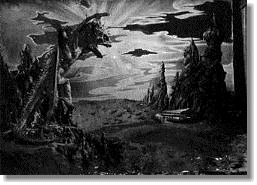 |
Jupiter Sketch |
Still of the Jupiter Creature & Ship |
He began his first big project EVOLUTION, which was to be a history of the world's beginnings using stop motion animation. His favorite part was to be about dinosaurs and he began his footage with them. This was an most ambitious project, but blinded by the aspiration of youth, Ray set to the task of on animating the 16mm film. Seeing the footage today hardly looks like the work of a young man working in his families garage. It is ambitiously animated and features a fellow student friend of Ray's encountering the prehistoric world. The only existing model from this film is a wooly mammoth that was never animated. The mammouth is beautifully detailed and covered with the fur of one his mother's fur coats, one that, Ray jokes, his mother never wore. The film came to a halt after Ray saw Disney's FANTASIA with contained the Stravinsky RITE OF SPRING segment. The existing footage for the film was not done in vain. It became useful to show this footage when he began seeking professional work as an animator to let people see what he was capable of.
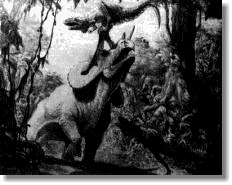 |
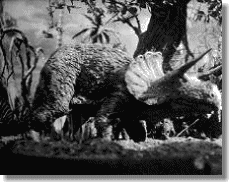 |
Ray was fascinated by contrast in size and had begun toying with the idea of bringing the biblical story of DAVID AND GOLIATH to the screen. While only sketches of the project were realized, it moved Ray further along in his early developmental years.
 |
High School had ended for Ray, and he soon found himself hired by George Pal, thanks to the footage from EVOLUTION, to help in the animation of a series of "PUPPETOONS" he was creating. It wasn't the type of animation that Ray wanted to do but he loved the work and the subject matter and this job was a doorway into the industry. Ray worked for 2 years with George Pal and helped with the animation of the first 12 PUPPETOONS released by Paramount. Now Ray found himself with a new challenge.
 War
had begun in Europe and it was only a matter of time before the United States
would become actively involved. Ray became part of the Army Motion Picture
Unit, under Frank Capra, during WWII where he began using animation
to illustrate the films, allowing him to contribute to the filmmaking history
of this monumental event. All the skill and training he had learned would
be put to a practical use while he would learn even more about his craft
while getting real hands on training. Ray also began is training in scrounging
when he discovered that the Navy had discarded several canisters of unused
but outdated film stock. He retrieved them from the trash planning
on using the film for his own projects
War
had begun in Europe and it was only a matter of time before the United States
would become actively involved. Ray became part of the Army Motion Picture
Unit, under Frank Capra, during WWII where he began using animation
to illustrate the films, allowing him to contribute to the filmmaking history
of this monumental event. All the skill and training he had learned would
be put to a practical use while he would learn even more about his craft
while getting real hands on training. Ray also began is training in scrounging
when he discovered that the Navy had discarded several canisters of unused
but outdated film stock. He retrieved them from the trash planning
on using the film for his own projects
Returning from the war. He decided to begin work on that project. He began
creating a series of short fairy tales based
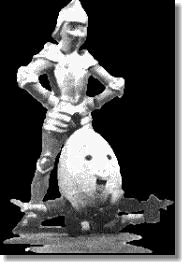 on
Mother Goose stories that would run about 3 minutes
a piece. The stories were in public domain so he wouldn't have any legal
problems. He approached several schools for suggestions and quickly learned
that he was not going to please everyone and decided to do the films the
way he wanted to see them. His parents became very supportive of Ray at this
time with his father, a machinist, helping to create the armatures
needed for the models and his mother helping him with the costumes and set
decorations, as well as the papier-mache heads for the dolls. His parents
names are listed in the credits as Fred Blasauf and Martha Reske. He
used is father's mother's surname to credit is father and his mother's maiden
name. Eventually these short subjects were placed together and an opening
and closing segment with Mother Goose was added. Ray continued creating these
animated children's stories, adapting LITTLE RED RIDING HOOD in 1949, HANSEL
AND GRETEL and THE STORY OF RAPUNZEL in 1951 and THE STORY OF KING MIDAS
in 1953. He had begun work on THE TORTOISE AND THE HAIR but Ray was
realizing that this shorts were taking up much of his life and he was aspiring
for bigger and better things. Also instrumental in these latter
films was Rays drama teacher at the LACC, Charlotte Knight. Ms. Knight
was and actress as well as a playwright and she helped contribute to the
Fairy Tales beginning with LITTLE RED RIDING HOOD. These short subjects are
still in non-theatrical circulation today and are used by many schools.
Follow this link for more on the MOTHER GOOSE/FAIRY
TALES including pictures from the series.
on
Mother Goose stories that would run about 3 minutes
a piece. The stories were in public domain so he wouldn't have any legal
problems. He approached several schools for suggestions and quickly learned
that he was not going to please everyone and decided to do the films the
way he wanted to see them. His parents became very supportive of Ray at this
time with his father, a machinist, helping to create the armatures
needed for the models and his mother helping him with the costumes and set
decorations, as well as the papier-mache heads for the dolls. His parents
names are listed in the credits as Fred Blasauf and Martha Reske. He
used is father's mother's surname to credit is father and his mother's maiden
name. Eventually these short subjects were placed together and an opening
and closing segment with Mother Goose was added. Ray continued creating these
animated children's stories, adapting LITTLE RED RIDING HOOD in 1949, HANSEL
AND GRETEL and THE STORY OF RAPUNZEL in 1951 and THE STORY OF KING MIDAS
in 1953. He had begun work on THE TORTOISE AND THE HAIR but Ray was
realizing that this shorts were taking up much of his life and he was aspiring
for bigger and better things. Also instrumental in these latter
films was Rays drama teacher at the LACC, Charlotte Knight. Ms. Knight
was and actress as well as a playwright and she helped contribute to the
Fairy Tales beginning with LITTLE RED RIDING HOOD. These short subjects are
still in non-theatrical circulation today and are used by many schools.
Follow this link for more on the MOTHER GOOSE/FAIRY
TALES including pictures from the series.
 Ray's induction
to the film industry came when Willis O'Brien contacted him to do work
on the new film he was involved in. Ray had become closely associated
to Mr. O'Brien and during one visit, he discovered O'Bie at work on a project
Called WAR EAGLES. O'Bie's walls were covered with over 200 fantastic
illustrations for the film. The WAR EAGLES project was abandoned and O'Bie
had become involved in another project that would reunite Cooper, Shoedsack,
O'Brien, Ruth Rose and Robert Armstrong . Not surprising, the
film dealt with a gorilla. That film became MIGHTY
JOE YOUNG (1949). During this time he learned more his craft from
the master and wound up doing about 85 per cent of the animation in the film.
One rousing sequence in the first half of MIGHTY
JOE YOUNG has Joe, a huge gorilla, toying with cowboys who are trying
to capture him. The work on this sequence must have been mind-boggling as
it moves from interaction between a stop-motion Joe and live action cowboys
who occasionally become stop-motion characters. There are many stop-motion
highlights to this film which includes a tug of war sequence between Joe
and a bunch of strongmen, including Primo Canera as the anchor man, and
a fantastic sequence with Joe on a drunken rampage, destroying a nightclub.
Here excellent stop-motion lions are flawlessly combined with live action
ones to create a sequence of terrific intensity. MIGHTY
JOE YOUNG proved to be financially successful, garnering an Academy Award
for Best Special Effects in 1949 as well as paving the way for Ray to
move on to new territory.
Ray's induction
to the film industry came when Willis O'Brien contacted him to do work
on the new film he was involved in. Ray had become closely associated
to Mr. O'Brien and during one visit, he discovered O'Bie at work on a project
Called WAR EAGLES. O'Bie's walls were covered with over 200 fantastic
illustrations for the film. The WAR EAGLES project was abandoned and O'Bie
had become involved in another project that would reunite Cooper, Shoedsack,
O'Brien, Ruth Rose and Robert Armstrong . Not surprising, the
film dealt with a gorilla. That film became MIGHTY
JOE YOUNG (1949). During this time he learned more his craft from
the master and wound up doing about 85 per cent of the animation in the film.
One rousing sequence in the first half of MIGHTY
JOE YOUNG has Joe, a huge gorilla, toying with cowboys who are trying
to capture him. The work on this sequence must have been mind-boggling as
it moves from interaction between a stop-motion Joe and live action cowboys
who occasionally become stop-motion characters. There are many stop-motion
highlights to this film which includes a tug of war sequence between Joe
and a bunch of strongmen, including Primo Canera as the anchor man, and
a fantastic sequence with Joe on a drunken rampage, destroying a nightclub.
Here excellent stop-motion lions are flawlessly combined with live action
ones to create a sequence of terrific intensity. MIGHTY
JOE YOUNG proved to be financially successful, garnering an Academy Award
for Best Special Effects in 1949 as well as paving the way for Ray to
move on to new territory.
Following MIGHTY JOE YOUNG, Willis O'Brien contacted Ray about another proposed project, THE VALLEY OF MIST. The story would combine elements of the western genre with dinosaurs. O'Bie had developed the idea with his wife Darlyne as EMILIO AND GALOSO and then later changed the title to EL TORO ESTRELLA. Producer Jesse L. Lasky Sr., became impressed with the concept and Paramount Pictures planned to release it. It was Lasky's idea to change the title of the film to THE VALLEY OF MIST, feeling that it was a much more marketable title. Jessy Laske Jr., completed the final screenplay but the project was eventually abandoned. During the preproduction period, Ray created several large charcoal drawings for the project, a few of which are pictured below
 |
 |
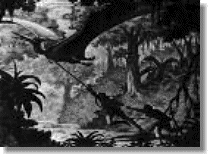 |
The 1950's were bringing a new audience to theaters. One that wanted to be thrilled by the latest innovations and discoveries in the field of science. While audiences were discovering the thrill of space flight in movies like ROCKETSHIP X-M (1950) and DESTINATION MOON (1950), Ray brought science fiction to earth with THE BEAST FROM 20,000 FATHOMS (1953). Based on a short story by Ray Bradbury called THE FOGHORN (published as THE BEAST FROM 20,000 FATHOMS in the Saturday Evening Post), Ray created a film in which a prehistoric beast is awakened after an atomic explosion and heads towards New York where it manages to destroy most of Coney Island before finally being destroyed. The film cost around $200,000 to produce and was picked up by Warner Brothers. It became an immediate success and more was wanted from Harryhausen.
 Ray heard
about a gentleman who had the desire to make a movie about a giant octopus
who rises out of the San Francisco Bay and destroys the Golden Gate Bridge.
They met and Ray was impressed with the gentleman and they agreed to make
the picture together. His name was Charles H. Schneer and the association
with Mr. Schneer would last through thirteen films and nearly three decades
of filmmaking. It would also continue a trend started in BEAST FROM 20,000
FATHOMS and run through many of his early films-the destruction of historical
or popular landmarks. To cut corners the Octopus would only have six tentacles,
but this is hardly noticeable in this highly entertaining film. The movie
was released in 1955 as IT CAME FROM BENEATH THE
SEA. During this time the monster-on-the-rampage films were becoming
popular world-wide. KING KONG was in re-release and doing well at the
box-office and THE BEAST FROM 20,000 FATHOMS had opened in Japan. The success
of these films in the box-office inspired a certain studio in Japan called
TOHO, to develop their own adaptation and created GODZILLA. You don't
need to stretch your imagination very far to see the similarities between
the original 1954 GODZILLA, or the 1998 remake for that matter, and Ray's
BEAST FROM 20,000 FATHOMS.
Ray heard
about a gentleman who had the desire to make a movie about a giant octopus
who rises out of the San Francisco Bay and destroys the Golden Gate Bridge.
They met and Ray was impressed with the gentleman and they agreed to make
the picture together. His name was Charles H. Schneer and the association
with Mr. Schneer would last through thirteen films and nearly three decades
of filmmaking. It would also continue a trend started in BEAST FROM 20,000
FATHOMS and run through many of his early films-the destruction of historical
or popular landmarks. To cut corners the Octopus would only have six tentacles,
but this is hardly noticeable in this highly entertaining film. The movie
was released in 1955 as IT CAME FROM BENEATH THE
SEA. During this time the monster-on-the-rampage films were becoming
popular world-wide. KING KONG was in re-release and doing well at the
box-office and THE BEAST FROM 20,000 FATHOMS had opened in Japan. The success
of these films in the box-office inspired a certain studio in Japan called
TOHO, to develop their own adaptation and created GODZILLA. You don't
need to stretch your imagination very far to see the similarities between
the original 1954 GODZILLA, or the 1998 remake for that matter, and Ray's
BEAST FROM 20,000 FATHOMS.
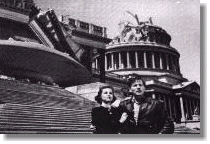 For Ray's
next film he brought aliens to Earth in EARTH VS.
THE FLYING SAUCERS (1956). This time Ray turned his vision of destruction
to Washington D.C. as the alien saucers invade the earth and are defeated
in the skies over the capital area. His realistic vision of flying saucers
remains burned in many minds as the definitive look for flying saucers on
the screen. Tim Burton's MARS ATTACKS is a perfect example. The scenes
of destruction are nothing short of marvelous and were later used in the
film THE GIANT CLAW (1957). Make no mistake-THE GIANT CLAW is not a Ray
Harryhausen film and even a casual viewer can notice the difference
of quality in the effects work.
For Ray's
next film he brought aliens to Earth in EARTH VS.
THE FLYING SAUCERS (1956). This time Ray turned his vision of destruction
to Washington D.C. as the alien saucers invade the earth and are defeated
in the skies over the capital area. His realistic vision of flying saucers
remains burned in many minds as the definitive look for flying saucers on
the screen. Tim Burton's MARS ATTACKS is a perfect example. The scenes
of destruction are nothing short of marvelous and were later used in the
film THE GIANT CLAW (1957). Make no mistake-THE GIANT CLAW is not a Ray
Harryhausen film and even a casual viewer can notice the difference
of quality in the effects work.
Irwin Allen approached Ray next to do the dinosaur animation segment in the almost forgotten film THE ANIMAL WORLD(1957). Ray teamed up with Willis O'Brien once again. Since this was a rush job with very little time to complete the project, Ray and O'Bie contributed to the only interesting part of this very dull film that combines the theories of evolution with biblical creation. In the end it is a film of little direction and is incredibly difficult to sit through except for the dinosaur segment. Many people only have exposure to the film from the Veiwmaster Set that was released. Today the movie is tied up in legal issues since the original film was made by several different photographers and the rights to the scenes they have filmed has reverted to them. Today, all the studio owns is the 13 minutes segment that was done by Ray Harryhausen and Willis O'Brien.
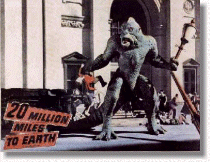 Following THE ANIMAL
WORLD Harryhausen brought life to a creature from Venus in the popular
20 MILLION MILES TO EARTH (1957). Ray had developed
a story idea called THE ELEMENTALS, in which alien eggs would arrive on Earth
unleashing giant bat like creatures to an unsuspecting Earth. Some
sketches were developed and Ray even created a stop-motion model filming
some test sequences in color the showed the creature attacking Ray. This
footage eventually surface to the public on the Criterion laserdisc release
of JASON AND THE ARGONAUTS but was shown in black and white. Excerpts
of the color footage can be seen in the televised documentary, THE RAY
HARRYHAUSEN CHRONICLES. Jack Deitz, of BEAST FROM 20,000
Following THE ANIMAL
WORLD Harryhausen brought life to a creature from Venus in the popular
20 MILLION MILES TO EARTH (1957). Ray had developed
a story idea called THE ELEMENTALS, in which alien eggs would arrive on Earth
unleashing giant bat like creatures to an unsuspecting Earth. Some
sketches were developed and Ray even created a stop-motion model filming
some test sequences in color the showed the creature attacking Ray. This
footage eventually surface to the public on the Criterion laserdisc release
of JASON AND THE ARGONAUTS but was shown in black and white. Excerpts
of the color footage can be seen in the televised documentary, THE RAY
HARRYHAUSEN CHRONICLES. Jack Deitz, of BEAST FROM 20,000
 FATHOMS had been pitched the story
and a screenplay was developed, but like many projects announced, this one
slipped into obscurity. Ray had also submitted a story idea called
THE GIANT YMIR. At the time, Dietz didn't see much potential in the story
and simply filed it away. Ray discussed the project with Charles Schneer
and, with a title change, 20 MILLION MILES TO EARTH was begun. This delightful
picture centers on a creature named Ymir (though it remains unnamed in the
film) who is brought to earth on a returning spaceship that crashes into
the Mediterranean. Only one astronaut survives the crash and with the creature
on the loose and growing at an alarming rate, the military forces are called
out to stop the creature during a fantastic sequence with the Coliseum in
Rome as a backdrop. The effects work in this film is remarkable, especially
the sequence with the fight between the Ymir and an elephant. Many regard
the YMIR as one of Ray's most popular creatures. Ray had another hit with
this film but it was Ray next venture in to land of Arabian mythology that
would really begin to give him the attention he truly deserved.
FATHOMS had been pitched the story
and a screenplay was developed, but like many projects announced, this one
slipped into obscurity. Ray had also submitted a story idea called
THE GIANT YMIR. At the time, Dietz didn't see much potential in the story
and simply filed it away. Ray discussed the project with Charles Schneer
and, with a title change, 20 MILLION MILES TO EARTH was begun. This delightful
picture centers on a creature named Ymir (though it remains unnamed in the
film) who is brought to earth on a returning spaceship that crashes into
the Mediterranean. Only one astronaut survives the crash and with the creature
on the loose and growing at an alarming rate, the military forces are called
out to stop the creature during a fantastic sequence with the Coliseum in
Rome as a backdrop. The effects work in this film is remarkable, especially
the sequence with the fight between the Ymir and an elephant. Many regard
the YMIR as one of Ray's most popular creatures. Ray had another hit with
this film but it was Ray next venture in to land of Arabian mythology that
would really begin to give him the attention he truly deserved.
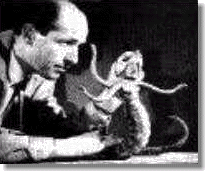 Ray turned
to the fantasy tales of Scheherazade for the first of four grand fantasy
adventures, THE 7TH VOYAGE OF SINBAD. It would
be his first feature film in color and the first pairing with the immortal
Bernard Herrmann, a film composer who created the
music for such classic films as Citizen Kane (1941), The Magnificent Ambersons
(1942), The Ghost and Mrs. Muir (1947) and later, Rear Window (1954), Vertigo
(1958) and Psycho (1960). For Ray's earlier works one creature served as
the driving force of his films, now the central figure was Sinbad, but rest
assurred, this film has no shortage of stop motion animation. This film would
create the immortal images of the Cyclops, The giant Dragons, The two-headed
flying Roc, the tiny princess
Ray turned
to the fantasy tales of Scheherazade for the first of four grand fantasy
adventures, THE 7TH VOYAGE OF SINBAD. It would
be his first feature film in color and the first pairing with the immortal
Bernard Herrmann, a film composer who created the
music for such classic films as Citizen Kane (1941), The Magnificent Ambersons
(1942), The Ghost and Mrs. Muir (1947) and later, Rear Window (1954), Vertigo
(1958) and Psycho (1960). For Ray's earlier works one creature served as
the driving force of his films, now the central figure was Sinbad, but rest
assurred, this film has no shortage of stop motion animation. This film would
create the immortal images of the Cyclops, The giant Dragons, The two-headed
flying Roc, the tiny princess
 and the
hand-maid who is turned into a serpent during one of Bernard Hermann's most
masterful scoring segments in the film. It is still the final duel between
Sinbad and a skeleton, though, that remains this films marvel. The interaction
between Kerwin Mathews as Sinbad and the stop-motion skeleton is stunning
and richly exciting. Mr. Harryhausen continues to credit much of the success
of this sequence to Kerwin Matthews uncanny ability to visualize the image
he is supposed to be seeing and give the sequences the much needed eye contact
between the actor and the animated figure, which would be inserted at a later
time. This sequence remains a marvel of screen magic. The combination of
Matthews ability, Ray's masterfully matched stop-motion work and the stunning
score by Herrmann all combine to make one of the richest scenes ever put
on screen. On a personal note, I was five years old when my babysitter
took me to the there to see this film. As I glared at the poster she
must have sensed that I was already getting scared. She explained that
the film wasn't scary, and that I would enjoy it. She was right, until
the skeleton sequence. For some reason, I connected with the fantasy
element of everything but that skeleton. I was convinced that it had
to be real. My babysitter tried to reassure me that it wasn't but then
she also told me that the movie wouldn't be scary. Vision of that skeleton
still dance through my dreams 35 years later.
and the
hand-maid who is turned into a serpent during one of Bernard Hermann's most
masterful scoring segments in the film. It is still the final duel between
Sinbad and a skeleton, though, that remains this films marvel. The interaction
between Kerwin Mathews as Sinbad and the stop-motion skeleton is stunning
and richly exciting. Mr. Harryhausen continues to credit much of the success
of this sequence to Kerwin Matthews uncanny ability to visualize the image
he is supposed to be seeing and give the sequences the much needed eye contact
between the actor and the animated figure, which would be inserted at a later
time. This sequence remains a marvel of screen magic. The combination of
Matthews ability, Ray's masterfully matched stop-motion work and the stunning
score by Herrmann all combine to make one of the richest scenes ever put
on screen. On a personal note, I was five years old when my babysitter
took me to the there to see this film. As I glared at the poster she
must have sensed that I was already getting scared. She explained that
the film wasn't scary, and that I would enjoy it. She was right, until
the skeleton sequence. For some reason, I connected with the fantasy
element of everything but that skeleton. I was convinced that it had
to be real. My babysitter tried to reassure me that it wasn't but then
she also told me that the movie wouldn't be scary. Vision of that skeleton
still dance through my dreams 35 years later.
Ray's next film was THE 3 WORLDS OF GULLIVER
(1960) and he now found himself in Europe so he could make use of the sodium
process allowing for quicker manipulation of special effects work. The sodium
process also allowed for more use of colors than did the standard Blue Screen
backing method that is the widely used
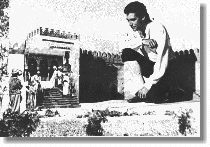 today. For this film there
was less emphasis on stop-motion work with many of the miniatures actually
being done by live actors in the miniature world of Lilliput and with Kerwin
Mathews becoming the miniature when he reached the shores of Brobdingnag.
Again, Matthews manages to capture the innocence of the film in his character
and to reveal, to a much greater extent, that ability of creating the sense
of being in the same scene with objects that wouldn't be inserted until a
later time. Much use was also made of forced perspective in this film. This
process uses precise camera angles to shoot Kerwin Matthews up close against
a full scale set and make them appear to be interacting with one another
in the same place. This gave the illusion of a very large Matthews opposite
the very small Lilliputions without going into the great expense of optical
effects. This film was also scored by Herrmann.
today. For this film there
was less emphasis on stop-motion work with many of the miniatures actually
being done by live actors in the miniature world of Lilliput and with Kerwin
Mathews becoming the miniature when he reached the shores of Brobdingnag.
Again, Matthews manages to capture the innocence of the film in his character
and to reveal, to a much greater extent, that ability of creating the sense
of being in the same scene with objects that wouldn't be inserted until a
later time. Much use was also made of forced perspective in this film. This
process uses precise camera angles to shoot Kerwin Matthews up close against
a full scale set and make them appear to be interacting with one another
in the same place. This gave the illusion of a very large Matthews opposite
the very small Lilliputions without going into the great expense of optical
effects. This film was also scored by Herrmann.
Turning to Jules Verne, Harryhausen's next film was
MYSTERIOUS ISLAND (1961). A truly exciting sequel
of sorts to Disney's 20,000 LEAGUES UNDER THE SEA. In this film prisoners
during the Civil War make their escape in a giant hot air balloon and soon
find themselves stranded on an island complete with, among other things,
an active volcano. On the island they discover that many of it's indigenous
creatures have grown to dangerous proportions including a giant crab that
would like to make a quick meal out of them. Other
 fantastic
sequences include a giant chicken-like creature (the prehistoric Phororhacos),
giant bee, and another giant octopus. These scenes are all animated with
gleeful delight and are a joy to watch. It is interesting to note that this
is also one of Harryhausen's most character driven pieces. There is more
cast motivation here than just moving characters from one special effects
sequence to another. Much of this must be attributed to director Cy Endfield.
In a conversation with Bruce Crawford, who has
produced a fantastic radio documentary on PBS on Herrmann as well as hosted
a revival screening of MYSTERIOUS ISLAND and JASON AND THE ARGONAUTS with
Ray Harryhausen present, Bruce suggested that I take a closer look at the
scene where Gary Merrill is discovered on the beach after the balloon has
crashed in the ocean. During the final moments of the scene, Nemo (played
by Herbert Lom), who has rescued Merrill can be seen in a few brief frames
at the top of the screen. He appears at a crevasse and is checking to make
sure that Merrill has been discovered by his friends. It is touches like
this that help give the film it's strength in it's characters. Once again,
Herrmann's fantastic scoring adds to the enjoyment of the film.
fantastic
sequences include a giant chicken-like creature (the prehistoric Phororhacos),
giant bee, and another giant octopus. These scenes are all animated with
gleeful delight and are a joy to watch. It is interesting to note that this
is also one of Harryhausen's most character driven pieces. There is more
cast motivation here than just moving characters from one special effects
sequence to another. Much of this must be attributed to director Cy Endfield.
In a conversation with Bruce Crawford, who has
produced a fantastic radio documentary on PBS on Herrmann as well as hosted
a revival screening of MYSTERIOUS ISLAND and JASON AND THE ARGONAUTS with
Ray Harryhausen present, Bruce suggested that I take a closer look at the
scene where Gary Merrill is discovered on the beach after the balloon has
crashed in the ocean. During the final moments of the scene, Nemo (played
by Herbert Lom), who has rescued Merrill can be seen in a few brief frames
at the top of the screen. He appears at a crevasse and is checking to make
sure that Merrill has been discovered by his friends. It is touches like
this that help give the film it's strength in it's characters. Once again,
Herrmann's fantastic scoring adds to the enjoyment of the film.
 Returning to mythology,
Ray began work on a film he was calling JASON AND THE GOLDEN FLEECE. During
the final moments of the creation of the film, it was discovered that the
Italians were releasing a muscleman picture called THE GOLDEN FLEECE and
it was decided to change the name of the film to JASON
AND THE ARGONAUTS (1963). For many fans, this is the masterpiece of Ray
Harryhausen's career. In no other of the classic Harryhausen films does the
combination of storytelling, special effects, casting, cinematography and
music come together as masterfully as in this film. Each effects sequence
in the film could have been a movie in itself but the story is tightly woven
and moves at a breathtaking pace from the film's beginning to its exciting
conclusion. The story focuses on Jason and his attempt to regain his kingdom
by travelling on a perilous journey to obtain the Golden Fleece. He gathers
the greatest men of the time, including Hercules, and sets out on a ship
with the help of the gods. The film is told in mythical proportions with
the gods' sequences filtered with a cloudlike image floating around them,
and each effects sequence containing the aura of reality that easily tricks
the viewer in to the suspension of disbelief that is rarely seen on the screen.
When the giant bronze statue
Talos
Returning to mythology,
Ray began work on a film he was calling JASON AND THE GOLDEN FLEECE. During
the final moments of the creation of the film, it was discovered that the
Italians were releasing a muscleman picture called THE GOLDEN FLEECE and
it was decided to change the name of the film to JASON
AND THE ARGONAUTS (1963). For many fans, this is the masterpiece of Ray
Harryhausen's career. In no other of the classic Harryhausen films does the
combination of storytelling, special effects, casting, cinematography and
music come together as masterfully as in this film. Each effects sequence
in the film could have been a movie in itself but the story is tightly woven
and moves at a breathtaking pace from the film's beginning to its exciting
conclusion. The story focuses on Jason and his attempt to regain his kingdom
by travelling on a perilous journey to obtain the Golden Fleece. He gathers
the greatest men of the time, including Hercules, and sets out on a ship
with the help of the gods. The film is told in mythical proportions with
the gods' sequences filtered with a cloudlike image floating around them,
and each effects sequence containing the aura of reality that easily tricks
the viewer in to the suspension of disbelief that is rarely seen on the screen.
When the giant bronze statue
Talos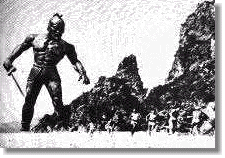 comes to
life your mind doesn't argue that this can't possibly be happening. You find
yourself caught up in the story and just simply accepting it's possibilities.
This sequence is probably among the films most fantastic and suspenseful,
brought richly to life by Ray's stop-motion effects work and sound effects
that turn this rubber cast model of about 18 inches into a towering metal
creature of terrifying proportions. Other sequences in this film include
the seven-headed hydra and the technically stunning Skeleton sequence that
has Jason and his men battling seven skeletons. This effect alone took four
and a half months to create even though it runs for only a few minutes on
the screen. The dazzling effect created here flows so smoothly that it's
hard to imagine the amount of work it took to animate the seven figures.
The music that Bernard Herrmann wraps this sequence in is again stunning
and helps to create the nightmarish vision. During the presentation of the
Academy of Motion Picture Arts and Sciences Golden Sawyer Award to Ray
Harryhausen in 1992, host Tom Hanks would comment that "some say Citizen
Kane is the greatest motion picture of all time, others say it's Casablanca,
for me, the greatest picture of all time is JASON AND THE ARGONAUTS."
comes to
life your mind doesn't argue that this can't possibly be happening. You find
yourself caught up in the story and just simply accepting it's possibilities.
This sequence is probably among the films most fantastic and suspenseful,
brought richly to life by Ray's stop-motion effects work and sound effects
that turn this rubber cast model of about 18 inches into a towering metal
creature of terrifying proportions. Other sequences in this film include
the seven-headed hydra and the technically stunning Skeleton sequence that
has Jason and his men battling seven skeletons. This effect alone took four
and a half months to create even though it runs for only a few minutes on
the screen. The dazzling effect created here flows so smoothly that it's
hard to imagine the amount of work it took to animate the seven figures.
The music that Bernard Herrmann wraps this sequence in is again stunning
and helps to create the nightmarish vision. During the presentation of the
Academy of Motion Picture Arts and Sciences Golden Sawyer Award to Ray
Harryhausen in 1992, host Tom Hanks would comment that "some say Citizen
Kane is the greatest motion picture of all time, others say it's Casablanca,
for me, the greatest picture of all time is JASON AND THE ARGONAUTS."
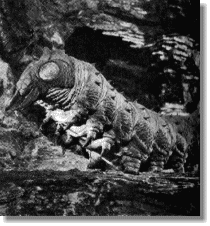 Ray
turned to space travel for his next film, FIRST MEN
IN THE MOON (1964). It was the first Harryhausen film produced in Cinemascope
and includes some impressive stop-motion effects work and terrific miniature
sets. While the story moves a little slower than the usual Harryhausen film
and takes much longer until the fantastic elements come into being, the final
half of the film is as richly entertaining as any Harryhausen film. Ray has
taken some heat about the fact that the Selenites are actually children in
big bug suites but, as Ray has explained, it would have taken years to animate
all of the Selenites. To his credit, during the scenes in which stop-motion
is used on the Selenites, they possess that wonderful otherworldly look that
Ray can breath into his characters. Also featured in the film is the giant
moon-calf, a monstrous caterpillar like creature that serves as food for
the Selenites and as a threat to the 2 male leads in the film. The
film is wonderfully scripted and moves from the a modern landing on the moon
to Victorian times which are delightfully recreated. The inclusion
of the idea of a simple human cold destroying all life on the moon is a fitting
nod and tribute to H.G. Welles WAR OF THE WORLDS, another project that Ray
had plans for, creating sketches and a model for the Martian creatures but
was never developed.
Ray
turned to space travel for his next film, FIRST MEN
IN THE MOON (1964). It was the first Harryhausen film produced in Cinemascope
and includes some impressive stop-motion effects work and terrific miniature
sets. While the story moves a little slower than the usual Harryhausen film
and takes much longer until the fantastic elements come into being, the final
half of the film is as richly entertaining as any Harryhausen film. Ray has
taken some heat about the fact that the Selenites are actually children in
big bug suites but, as Ray has explained, it would have taken years to animate
all of the Selenites. To his credit, during the scenes in which stop-motion
is used on the Selenites, they possess that wonderful otherworldly look that
Ray can breath into his characters. Also featured in the film is the giant
moon-calf, a monstrous caterpillar like creature that serves as food for
the Selenites and as a threat to the 2 male leads in the film. The
film is wonderfully scripted and moves from the a modern landing on the moon
to Victorian times which are delightfully recreated. The inclusion
of the idea of a simple human cold destroying all life on the moon is a fitting
nod and tribute to H.G. Welles WAR OF THE WORLDS, another project that Ray
had plans for, creating sketches and a model for the Martian creatures but
was never developed.
 Returning
to dinosaurs, Ray was approached by Michael Carreras of Hammer Films to do
effects work on a film they were making called ONE
MILLION YEARS B.C. (1967), a remake of the 1940 Victor Mature picture.
Unfortunately for the film, corners were cut and not all of the dinosaurs
are stop-motion creations. At times lizards were enlarged and filmed with
high-speed cameras much the same as had been done with the FLASH GORDON films
and in the original ONE MILLION B.C. It wasn't a realistic effect then and
it isn't in this film either. It isn't until the stop-motion special effects
work of Ray Harryhausen hits the screen that the film truly shines. The dinosaurs
in this film are among Harryhausen's best dinosaur animations. The battle
sequences are perfectly staged and the pterodactyl sequence with Racquel
Welch is terrific. The influence of this film can be seen in the number of
films that parody it, including CAVEMAN with Ringo Starr and Barbara Bach.
Hammer Studios followed this film with two more caveman film, WHEN DINOSAURS
RULE THE EARTH, which included effects work by Jim Danforth, and the dreadful
CREATURES THE WORLD FORGOT. It should have been called The Creatures
That Hammer Forgot since it features no dinosaurs. Ray commented that
he often wondered if people went to see Racquel or his dinosaurs. I can't
help but feel that, whatever reason they went, they left the theater remembering
the dinosaurs.
Returning
to dinosaurs, Ray was approached by Michael Carreras of Hammer Films to do
effects work on a film they were making called ONE
MILLION YEARS B.C. (1967), a remake of the 1940 Victor Mature picture.
Unfortunately for the film, corners were cut and not all of the dinosaurs
are stop-motion creations. At times lizards were enlarged and filmed with
high-speed cameras much the same as had been done with the FLASH GORDON films
and in the original ONE MILLION B.C. It wasn't a realistic effect then and
it isn't in this film either. It isn't until the stop-motion special effects
work of Ray Harryhausen hits the screen that the film truly shines. The dinosaurs
in this film are among Harryhausen's best dinosaur animations. The battle
sequences are perfectly staged and the pterodactyl sequence with Racquel
Welch is terrific. The influence of this film can be seen in the number of
films that parody it, including CAVEMAN with Ringo Starr and Barbara Bach.
Hammer Studios followed this film with two more caveman film, WHEN DINOSAURS
RULE THE EARTH, which included effects work by Jim Danforth, and the dreadful
CREATURES THE WORLD FORGOT. It should have been called The Creatures
That Hammer Forgot since it features no dinosaurs. Ray commented that
he often wondered if people went to see Racquel or his dinosaurs. I can't
help but feel that, whatever reason they went, they left the theater remembering
the dinosaurs.
Continuing on the dinosaur theme, Ray went on to create
THE VALLEY OF GWANGI (1969) which combined elements
of the American westerns with dinosaur films when a travelling western
sideshow encounters a hidden valley that contains the last remnants of
prehistoric life. Capturing an Allosaurus, they attempt to
 exploit
it for personal gain, but the creature escapes and begins creating carnage.
The effects work in this film is skillfully executed though in a battle between
the Tyrannosaurus and an elephant, the elephant does not come across as
realistically as the same type of battle in 20 MILLION MILES TO EARTH. On
the other hand, the sequence featuring the cowboys roping GWANGI rivals the
similar sequence in Mighty Joe Young. Here, in color, the execution of that
sequence is rich in detail and brilliantly created. Reportedly, this sequence
took 5 months to create. This film is sadly passed off today by many and
see it as a beginning of a lull in the creative forces of Harryhausen. Actually
the film is impressively executed and contains some stunning effects work
by Harryhausen. Unfortunately audiences were losing their taste for these
pictures and they movie did poorly at the box-office. An interesting sidenote
is the fact that the film was based on an idea developed by Willis O'Brien.
exploit
it for personal gain, but the creature escapes and begins creating carnage.
The effects work in this film is skillfully executed though in a battle between
the Tyrannosaurus and an elephant, the elephant does not come across as
realistically as the same type of battle in 20 MILLION MILES TO EARTH. On
the other hand, the sequence featuring the cowboys roping GWANGI rivals the
similar sequence in Mighty Joe Young. Here, in color, the execution of that
sequence is rich in detail and brilliantly created. Reportedly, this sequence
took 5 months to create. This film is sadly passed off today by many and
see it as a beginning of a lull in the creative forces of Harryhausen. Actually
the film is impressively executed and contains some stunning effects work
by Harryhausen. Unfortunately audiences were losing their taste for these
pictures and they movie did poorly at the box-office. An interesting sidenote
is the fact that the film was based on an idea developed by Willis O'Brien.
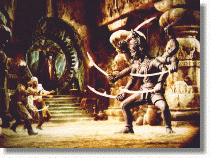 For Ray's final films he would
return to the world of mythology. His final three features would include
two Sinbad films and a return to the land of Argos. For the first of the
three, the GOLDEN VOYAGE OF SINBAD (1974) brings
the Arabian adventurer back to the screen to battle fantastic creations like
the six-armed Kali, a stone goddess brought to life by a magician played
by Tom Baker who was featured as Doctor Who in the popular BBC TV series.
Baker's performance as the evil magician helps provide the film with character
and purpose playing against John Phillip Law's Sinbad. Also appearing in
the film is Caroline Munro who provides the beautiful love interest for Sinbad.
Other fantastic effects scenes include a battle between a one-eyed centaur
and a giant winged-eagle. There is also a wonderfully animated tiny harpie-like
creature, the Homunculous, that appears throughout the film.
For Ray's final films he would
return to the world of mythology. His final three features would include
two Sinbad films and a return to the land of Argos. For the first of the
three, the GOLDEN VOYAGE OF SINBAD (1974) brings
the Arabian adventurer back to the screen to battle fantastic creations like
the six-armed Kali, a stone goddess brought to life by a magician played
by Tom Baker who was featured as Doctor Who in the popular BBC TV series.
Baker's performance as the evil magician helps provide the film with character
and purpose playing against John Phillip Law's Sinbad. Also appearing in
the film is Caroline Munro who provides the beautiful love interest for Sinbad.
Other fantastic effects scenes include a battle between a one-eyed centaur
and a giant winged-eagle. There is also a wonderfully animated tiny harpie-like
creature, the Homunculous, that appears throughout the film.
Following GOLDEN VOYAGE with SINBAD AND THE EYE OF THE TIGER (1977). Ray once again committed some fine effects sequences on the screen. Among the fantastic effects in this film was the animation of a life-size baboon who at times was so skillfully executed, many thought the creature was real.
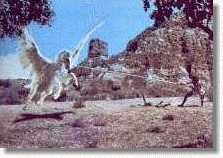 Ray's last film was
CLASH OF THE TITANS (1981) in which he creates
another epic adventure like JASON AND THE ARGONAUTS. With a stellar cast
and an impressive budget, it is still the effects work of Ray Harryhausen
that takes this film from being a muscleman picture into the realm of the
fantastic. His animation of Pegasus is nothing short of beautiful and is
contrasted by the hideous and vile Medusa and the satanic looking Calibos.
When I first developed this page, Ray read it and commented about a
negative remark about Laurence Olivier's performance as Zeus. I decided
that, to be fair, I would watch the film again. While I still feel that it
lacks the charm and personality of Niall MacGuiness performance in Jason
And The Argonauts, he does strike a commanding interpretation of a vengeful
and often jealous Zeus. While the secondary casting of Ursula Andress,
Burgess Meredith and Maggie Smith are all excellent, Harry Hamilin's performance
as Perseus is far less animated than anything the Ray has ever put on the
screen. It does feature one of the finest effects sequences involving
the Medusa ever put on film. The blending of the lighting and the fearful
presence that Ray gives this creature make her a most menacing foe. Thanks
to repeated screenings by Ted Turner on TBS and TNT, this film has become
the most accessible of all of Ray's films.
Ray's last film was
CLASH OF THE TITANS (1981) in which he creates
another epic adventure like JASON AND THE ARGONAUTS. With a stellar cast
and an impressive budget, it is still the effects work of Ray Harryhausen
that takes this film from being a muscleman picture into the realm of the
fantastic. His animation of Pegasus is nothing short of beautiful and is
contrasted by the hideous and vile Medusa and the satanic looking Calibos.
When I first developed this page, Ray read it and commented about a
negative remark about Laurence Olivier's performance as Zeus. I decided
that, to be fair, I would watch the film again. While I still feel that it
lacks the charm and personality of Niall MacGuiness performance in Jason
And The Argonauts, he does strike a commanding interpretation of a vengeful
and often jealous Zeus. While the secondary casting of Ursula Andress,
Burgess Meredith and Maggie Smith are all excellent, Harry Hamilin's performance
as Perseus is far less animated than anything the Ray has ever put on the
screen. It does feature one of the finest effects sequences involving
the Medusa ever put on film. The blending of the lighting and the fearful
presence that Ray gives this creature make her a most menacing foe. Thanks
to repeated screenings by Ted Turner on TBS and TNT, this film has become
the most accessible of all of Ray's films.
In the end, Ray Harryhausen's contribution to the world of film-making can not go unnoticed. He has truly paved the way for others and has served as the inspiration for modern films like the effects work of the STAR WARS films and Speilberg's JURRASIC PARK. Like the subject matter that Mr. Harryhausen often dealt with, his work has reached it's own level of immortality. His films have truly stood the test of time and still bring joy to the many who continue to watch them and to those new-comers who discover's Ray's truly fantastic world of films..
Occasionally Ray can be spotted in a film doing a cameo. Director John Landis, a avid fan of Ray's films, used him in BEVERLY HILLS COP 2 and in SPIES LIKE US. He has just finished filming a cameo for the remake of MIGHTY JOE YOUNG with Terry Moore, who played Jill in the original as a husband and wife. These appearances only testify to the far reaching effect that Ray's body of work has had on those who have seen his films.
Since Ray has stopped making films, he has been busy attending fan conventions and, being the gentleman that he is always takes time to sign autographs and talk with the people who love his films. Ray has finally gained the accolades of his peers when he received the Golden Sawyer Lifetime Achievement Academy Award in 1992 for his contribution to the world of cinema. You cannot help but ask yourself where it would have been without him. Of the hundreds of muscleman pictures dealing with the legends of Greek and Roman mythology it is Ray's films that will endure. It is the work of this skillful craftsman that is embedded in our memory, just close your eyes and think about the Cyclops of Sinbad and see how quickly you can visualize him. The same can be said of Ray's entire body of work.
A few years ago a documentary was made focusing on the films of Harryhausen called ALIENS, DRAGONS, MONSTERS AND ME. While not a serious study of his work it's fun to watch and contains clips from much of his early projects. Fans will also want to check out THE PUPPETOON MOVIE which includes several of the George Pal films that included effects work done by Ray and Willis O'Brien. In the beginning of 1998, AMC ran THE HARRYHAUSEN CHRONICLES, a documentary on Ray that is a fan's delight. It approaches Ray's films in a serious manner and is targeted for a much more mature audience than ALIENS, DRAGONS MONSTERS AND ME. Many extremely rare sequences from Ray's unseen early work are woven through this special and is a must see for anyone who appreciates the genius of Ray's work.
It has been a joy to see that Ray Harryhausen's films are no longer being discussed by serious film critics as "B" titles. Indeed, from THE 7TH VOYAGE OF SINBAD on, there is nothing to indicate the "B" status. THE 7TH VOYAGE OF SINBAD was made for over $2 million dollars, hardly a "B" status budget for that time period. From that film upward the budgets of the films only increased. Even films that were panned by the critics, like THE VALLEY OF GWANGI, are now getting the attention they deserve and many of the critics are singing a different tune. Like the legends he has passed on through he films, Ray Harryhausen has entered his own legend in that immortal hall of heroes that will endure as long as his films are remembered. From the look of things, that's going to be a very, very long time.
As you can tell, I am an avid fan of Ray Harryhausen and absolutely enjoy his entire body of work. I was once questioned, "What is it about these films and Ray harryhausen that has made you feel this way about them?" I thought about for a little and replied with this. During the final moments of THE MALTESE FALCON (1941), Sam Spade (played by Humphrey Bogart) is questioned as to what, exactly, the Maltese Falcon really is. Spade's reply has reached it's own level of immortality as he utters the words "It's the stuff that dreams are made of!" If those words are true than surely Mr. Harryhausen is that Maltese Falcon.
NOTE: This page had been used, virtually intact, with my permission on the 4 CD-ROM set FORREST J ACKERMAN'S MUSEUM OF SCIENCE FICTION HORROR AND FANTASY. It's a stunning tribute to Forry's fantastic collection of Sci-Fi, Horror and Fantasy. Containing 2.6 gigabytes of photos, video clips and movies, this is truly a must have for any fans of the genre. For more information, check out www.4ecd.com.
Since the initial posting of this page I had the great pleasure of meeting Ray Harryhausen during the 65th ANNIVERSARY KING KONG EVENT in Omaha Nebraska. I have Bruce Crawford to thank for this. I have come away from this event with a much greater and far deeper respect for Ray Harryhausen. Something that I didn't think was possible. The above link will take you to a page where I have chosen to indulge myself with a full report on the weekend that allowed me to personally see the human side of Mr. Harryhausen. It also allowed me to see that the creative spark of genius that gave my life so much pleasure through his films still burns brightly within him.

|
Profile
| Image
Gallery |
Filmography
| Text
Archive |
Misc.
| King
Kong Event|
Please e-mail and let me know what you think. I'm open to any
comments or suggestion that you think would help this page.
 send
email to Jim Rodkey.
send
email to Jim Rodkey.